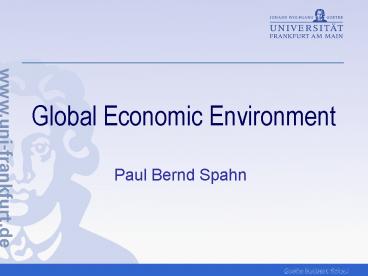Global Economic Environment PowerPoint PPT Presentation
1 / 17
Title: Global Economic Environment
1
Global Economic Environment
Paul Bernd Spahn
2
Preliminaries
- Instructor
- Learning method
- Textbook
- Course content
- Assignments
- Readings
- Self-evaluation test
- Group work 1 Discussion Board (CENTRA)
- Group work 2 Project (case study)
- Final exam
3
Honor code
4
Learning platform
- We are exclusively using the Fuqua Learning
Platform for discussions, chats, bulletin board
etc.
5
Chapter I Introduction
- A. Motivation of the Course
- B. Principal topics covered
6
Why is macroeconomics important for businesses?
- Business often considers the institutional and
economic environment for a firms operations as
given - But optimizing business in a deteriorating
macroeconomic environment is futile - And there is competition between different
economic systems at world scale - Disregarding the global macro economy is a
dangerous and myopic strategy
7
Macroeconomics and the firm
Sources of Corporate Uncertainty
Environment
Idiosyncratic
Macroeconomic
- Political stability- Rule of Law-
Openness- Competition policy- Labor
regulations- Taxes, social costs-
Infrastructure- Human Capital
- Stable growth- Income levels- Employment -
Price stability- Wage rates- Interest rates-
Exchange rates- Sustainable policies
- Market position- Quality of labor- Technology
- Energy- Productivity- Costs- Innovation -
Specific risks
8
Growth and employment
- Stable growth and high employment generate a
favorable climate for a firms economic expansion - High employment generates broad and often high
incomes - High employment means less poverty and lower
social costs - Income also supports domestic demand
9
Financial stability
- Stable price levels lower information costs and
allow better planning of revenues and costs - The general price level also affects wage rates
and interest rates - Stable exchange rates are particularly important
for exporters and importers, but also for
international direct and indirect investors - Financial volatility entails risks and hence
costs - Predictable and sustainable economic policies of
government are crucial for a firms success
10
Inflation
- Inflation entails high information costs because
it is difficult to monitor - the real value of revenues and costs, in
particular capital costs and - the real value of assets and liabilities
- Inflation undermines long term planning and
contracting, in particular of investment - Inflation entails risks for a firm through short
term ad hoc state intervention
11
Exchange rate crises
- Crises of the exchange rate are disruptive for
international operations anchored in the crisis
currency - Such crises are often caused by, or alimented by,
short run speculation - Exchange rate crises also affect the local
economy (declining wealth) - Exchange rate crises often trigger state
intervention such as capital controls
12
Examples of exchange rate crises
Asian crisis 1997-98
Pound sterling 1992-94
13
How to explain this?
14
Government interventions
- Government policy is usually at its best if
focused on a stable and sustainable economic
environment for private operations - Some redistributive policies foster a stable
social environment and general prosperity - But regulations and the protection of social
entitlements may become costly for firms - State interventions can often be disruptive
15
Relevance of course
- General macroeconomics is highly important for
business decision making - The global economy will expand business
opportunities beyond traditional markets - So general macroeconomics has to be placed in a
global context - Global economics must take the political and
institutional conditions into account
16
Reading
- Reading 1-7 The fragility of perfection When
supply chains go wrong, The Economist, May 1st,
2008
17
What are the principal topics covered?
- Growth and efficiency
- Supply-side economics and demand management
- International differences in wage rates
- Inflation around the world
- International trade flows
- Global allocation of capital
- Monetary policy and interest rates
- International finance and exchange rates
18
Discussion 1Market economy its strengths and
its limits
- What are the principal advantages of a market
economy? - What are its principal drawbacks?
- Can the market economy be fair?
19
(No Transcript)

